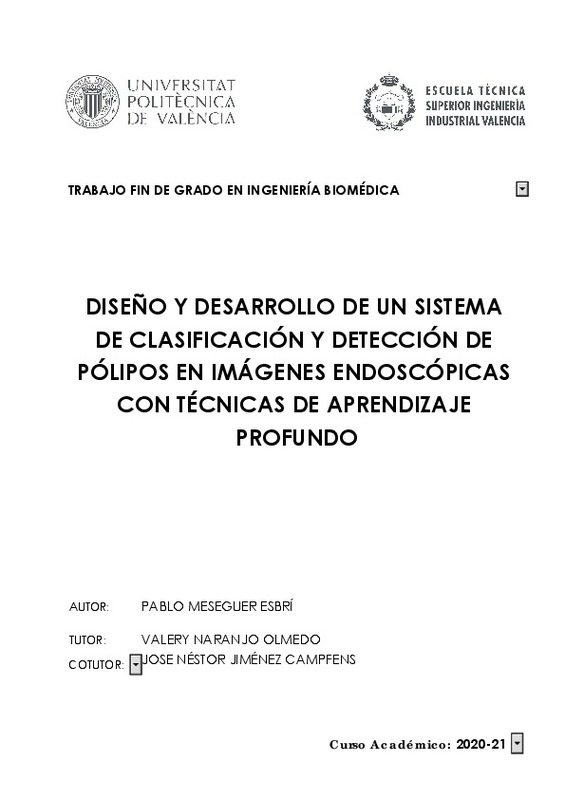JavaScript is disabled for your browser. Some features of this site may not work without it.
Buscar en RiuNet
Listar
Mi cuenta
Estadísticas
Ayuda RiuNet
Admin. UPV
Diseño y desarrollo de un sistema de clasificación y detección de pólipos en imágenes endoscópicas con técnicas de aprendizaje profundo
Mostrar el registro sencillo del ítem
Ficheros en el ítem
| dc.contributor.advisor | Naranjo Ornedo, Valeriana
|
es_ES |
| dc.contributor.advisor | Jiménez Campfens, José Néstor
|
es_ES |
| dc.contributor.author | Meseguer Esbrí, Pablo
|
es_ES |
| dc.date.accessioned | 2021-07-21T14:01:17Z | |
| dc.date.available | 2021-07-21T14:01:17Z | |
| dc.date.created | 2021-07-05 | |
| dc.date.issued | 2021-07-21 | es_ES |
| dc.identifier.uri | http://hdl.handle.net/10251/169698 | |
| dc.description.abstract | [ES] Propuesta de un sistema conjunto de clasificación y detección de pólipos en imágenes endoscópicas empleando técnicas de aprendizaje profundo o Deep Learning. Una correcta detección de pólipos durante las exploraciones endoscópicas resulta fundamental para reducir la probabilidad de aparición del cáncer de colón derivado de la malignización de estas lesiones. Ante esta problemática, las técnicas de Deep Learning se han demostrado como un buen soporte para los profesionales sanitarios puesto que facilitan la detección de este tipo de lesiones reduciendo la tasa de pólipos no detectados por los médicos. El sistema incluye una primera etapa de clasificación que se encarga de diferenciar las imágenes que presentan pólipos de las que no contienen este tipo de lesiones. Esta tarea se realiza con una red de clasificación cuya entrada es la imagen a analizar y cuya salida se corresponde con una etiqueta que indica si la imagen presenta o no un pólipo. Por su parte, la etapa de detección se divide en una tarea de segmentación y en otra de detección de objetos realizándose ambas para imágenes que sí presentan pólipos. Estas dos tareas se diferencian en la salida que ofrece el sistema siendo esta una imagen binaria o máscara para la segmentación y un rectángulo mínimo o bounding box para la detección de los pólipos. Todas las tareas mencionadas se realizan mediante Deep Learning y aprendizaje supervisado. Para ello se diseñan diferentes redes neuronales convolucionales o CNN ya sea entrenando las mismas desde cero o aplicando técnicas de transferencia de aprendizaje o Transfer Learning. | es_ES |
| dc.description.abstract | [EN] Proposal of system for classifying and detecting polyps in endoscopic images using Deep Learning techniques. Correct detection of polyps during endoscopic examinations is essential to reduce the likelihood of colon cancer arising from the malignancy of these lesions. Faced with this problem, Deep Learning techniques have proven to be a good support for healthcare professionals since they facilitate the detection of this type of injury by reducing the rate of polyps not detected by doctors. The system includes a first classification stage that is responsible for differentiating the images that present polyps from those that do not contain this type of lesion. This task is performed with a classification network whose input is the image to be analyzed and whose output corresponds to a label that indicates whether or not the image has a polyp. For its part, the detection stage is divided into a segmentation task and an object detection task, both being carried out for images that do present polyps. These two tasks differ in the output offered by the system, this being a binary image or mask for segmentation and a bounding box for the detection of polyps. Different convolutional neural networks (CNN) are designed either by training them from scratch or by applying or Transfer Learning techniques. | es_ES |
| dc.format.extent | 60 | es_ES |
| dc.language | Español | es_ES |
| dc.publisher | Universitat Politècnica de València | es_ES |
| dc.rights | Reconocimiento - No comercial - Sin obra derivada (by-nc-nd) | es_ES |
| dc.subject | Pólipo | es_ES |
| dc.subject | Cáncer de colon | es_ES |
| dc.subject | Deep Learning | es_ES |
| dc.subject | Aprendizaje supervisado | es_ES |
| dc.subject | Transfer Learning | es_ES |
| dc.subject | Redes neuronales convolucionales (CNN) | es_ES |
| dc.subject | Clasificación | es_ES |
| dc.subject | Detección | es_ES |
| dc.subject | Segmentación | es_ES |
| dc.subject | Polyp | es_ES |
| dc.subject | Colon cancer | es_ES |
| dc.subject | Supervised learning | es_ES |
| dc.subject | Convolutional neural networks | es_ES |
| dc.subject | Classification | es_ES |
| dc.subject | Detection | es_ES |
| dc.subject | Segmentation. | es_ES |
| dc.subject.classification | TEORIA DE LA SEÑAL Y COMUNICACIONES | es_ES |
| dc.subject.other | Grado en Ingeniería Biomédica-Grau en Enginyeria Biomèdica | es_ES |
| dc.title | Diseño y desarrollo de un sistema de clasificación y detección de pólipos en imágenes endoscópicas con técnicas de aprendizaje profundo | es_ES |
| dc.type | Proyecto/Trabajo fin de carrera/grado | es_ES |
| dc.rights.accessRights | Abierto | es_ES |
| dc.contributor.affiliation | Universitat Politècnica de València. Departamento de Comunicaciones - Departament de Comunicacions | es_ES |
| dc.contributor.affiliation | Universitat Politècnica de València. Escuela Técnica Superior de Ingenieros Industriales - Escola Tècnica Superior d'Enginyers Industrials | es_ES |
| dc.description.bibliographicCitation | Meseguer Esbrí, P. (2021). Diseño y desarrollo de un sistema de clasificación y detección de pólipos en imágenes endoscópicas con técnicas de aprendizaje profundo. Universitat Politècnica de València. http://hdl.handle.net/10251/169698 | es_ES |
| dc.description.accrualMethod | TFGM | es_ES |
| dc.relation.pasarela | TFGM\144005 | es_ES |
Este ítem aparece en la(s) siguiente(s) colección(ones)
-
ETSII - Trabajos académicos [10404]
Escuela Técnica Superior de Ingenieros Industriales






